Custom Mini Case for Macintosh LC, P475, Q605
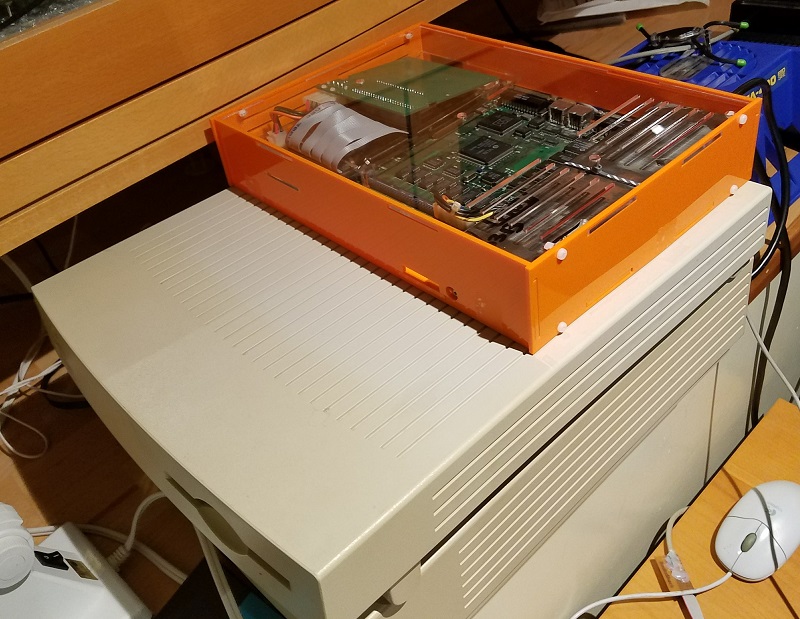
Here’s a custom laser-cut case for the Macintosh LC family, Performa 400 series, and Quadra 605. By removing the internal floppy drive and fan, and replacing the internal SCSI drive with a SCSI2SD board, I was able to make a design that’s about half the size of a standard LC case. The pieces fit together loosely with tabs and slots, and then screws and nuts in T-slots provide extra support to make everything nice and solid. The finished case isn’t much bigger than my keyboard, which is neat. Here it is outfit with a Floppy Emu and an ADB-USB Wombat:
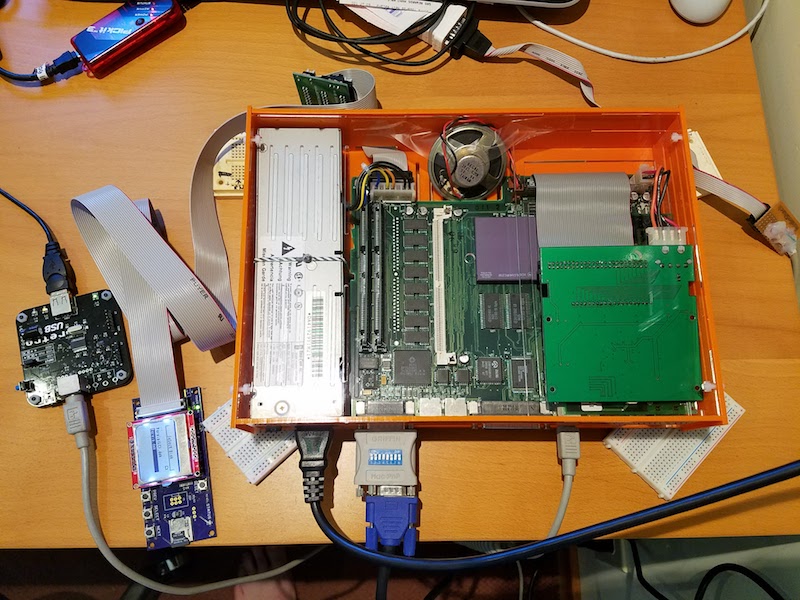
The logic board is screwed into the base piece, and the PSU is strapped down with zip ties. The case is a simple six-sided box, with the addition of a seventh interior piece that I call “the shelf.” This piece separates the rightmost interior region into lower and upper sections. The lower section houses any PDS plug-in card, and the SCSI2SD rests on top of the shelf in the upper section. Because of the way the SCSI cables are oriented, the SCSI2SD is mounted upside-down.
Here are the parts before assembly:
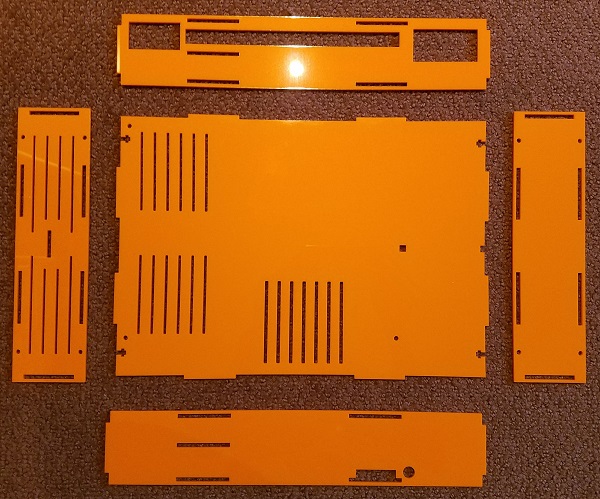
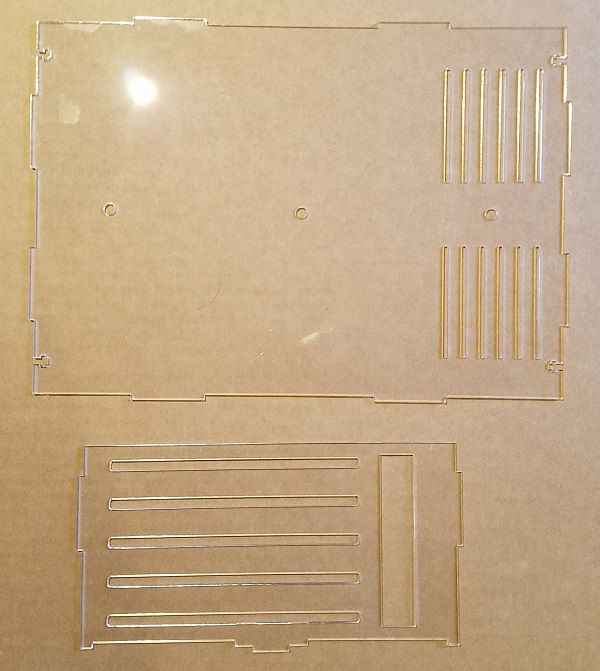
And the final product is shown at the top of this post. It’s an obnoxious shade of orange with a clear top. Who wants beige, anyway?
The speaker is taped to the inside of the case to prevent it from moving around, which is ugly. There’s not enough space for it to lie flat, so it’s propped up at a strange angle. I’ll hunt around for a smaller 16 ohm speaker to use in its place.
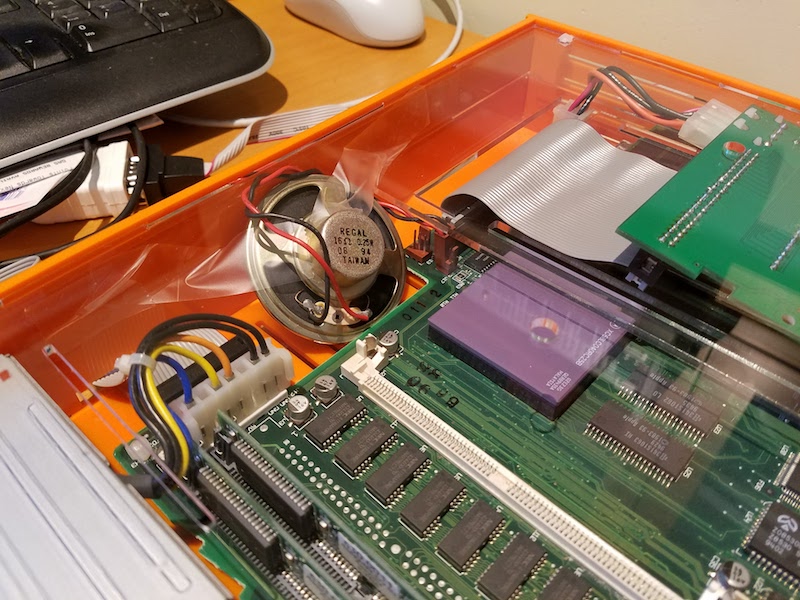
There’s a slot in the front where I’ve run a floppy ribbon cable, so I can hook up a Floppy Emu when needed.
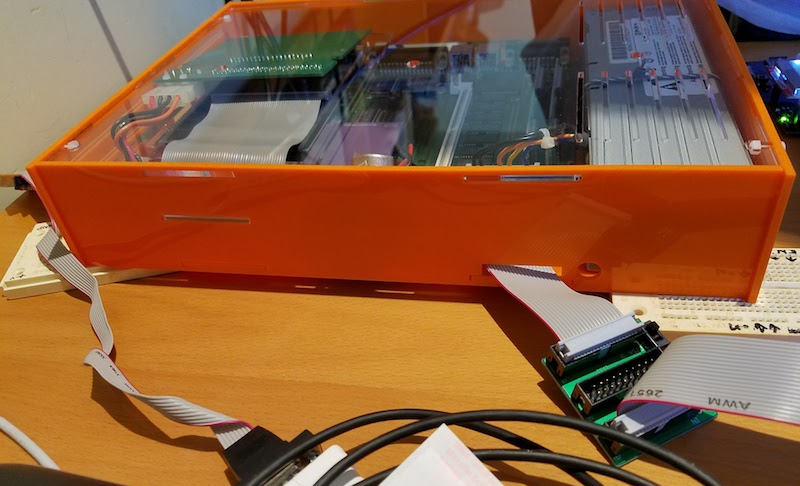
The space above and below the shelf is very cramped, and I probably should have made it larger. Initially I couldn’t get my PDS ethernet card to fit, but after shaving a few millimeters by removing the metal shield from around the ethernet jack, it just barely squeezes in. The SCSI2SD was also a very tight fit. Using a SCSI cable with integrated strain relief, it wouldn’t fit, and I had to substitute a different SCSI cable without strain relief that’s a couple of mm thinner.
The case opening for the PDS card is fine, but without the metal shield, there’s a gap around the ethernet jack. Bonus ventilation! Here’s a photo of that, along with the right side vents:
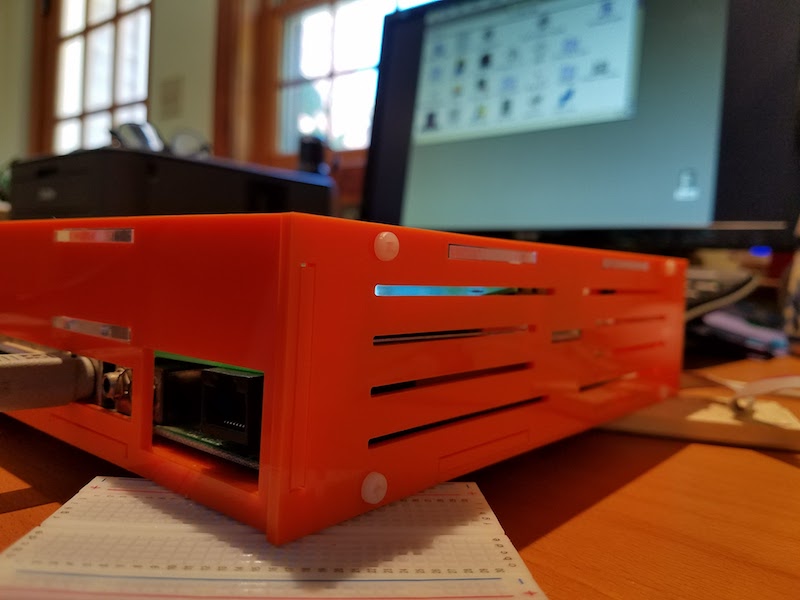
With no fan I thought the computer might overheat, so I was prepared to take some temperature measurements. Stuffed with the guts of a Performa 475, I used an IR thermometer to take some readings at different spots inside the case, and I couldn’t find anything warmer than 112 F / 44 C. I was ready to mount a tiny fan inside, but that doesn’t look necessary now since the passive cooling is adequate.
If anybody wants to build their own, or use this as a starting point for further experiments, take these files. There are two files: one for the bottom and sides, and one for the top and shelf, so you can have the two different sheets made in different colors. Upload the files to ponoko.com, and have each one cut on a P2 sized 3mm thick acrylic of your color choice. You can also use 3mm MDF wood if you want a different look. Along with the case pieces, you’ll need 11 M3x10mm screws with matching nuts. #4-40 size screws probably fit too, but I haven’t tried it. You’ll also want some plastic zip ties to strap down the power supply.
A few things I’d do differently, if I were going to do this again:
- Add about 3mm to the height under the shelf, to fit thicker PDS cards
- Add about 3mm to the height above the shelf, to fit thicker SCSI cables
- Integrate small feet into the side pieces, to elevate the case for better underside airflow
- Have fewer vents around the PSU, and more vents around the CPU and PDS card
- Cut the vent slots into the shape of an Apple logo
- Reposition the floppy cable slot, so it’s better aligned with the logic board’s floppy connector
- Add an opening for a power LED so I can tell when it’s on
Now back to playing with my little orange monster…
Read 6 comments and join the conversation6 Comments so far
Leave a reply. For customer support issues, please use the Customer Support link instead of writing comments.


Cooling update: after a few of hours of use, the case temperature with passive cooling crept up to 112 F / 44 C. That should still be fine, but it was enough for me to be curious how much a fan would help. Not much, as it turns out. I mounted a tiny 1-inch diameter fan over the bottom vents, in the same spot where I had the speaker earlier. I could definitely feel some warm air blowing out the top vents, so it was working, but it had an annoying high pitched sound. After an hour or so with the fan, the warmest spots were around 100 F / 38 C. A difference, but not a dramatic one.
I’ll probably remove the fan. I’m not sure how hot is “too hot”, and I’m not sure my temperature measurement method is the best, but I’ll arbitrarily define 140 F / 60 C as the red line. Although as long as the computer is still working and doesn’t glitch or crash, isn’t that the true test?
What’s interesting is that the hottest area isn’t the CPU or the power supply, but a couple of the support chips near the SCSI and serial ports. They run about 10-15 degrees F hotter than anything else I measured.
Throw some heat sinks on the chips if there is room. Those support chips usually aren’t directly cooled in the stock cases anyway. Another option to shrink the case further… a pico PSU and external power brick. ReactiveMicro used to sell an adapter for the IIgs that likely can be adapted for use in a LC series machine. Looks like the pinout from the power supplies is identical (minus the -12v line on the LC series).
http://www.reactivemicro.com/product_info.php?products_id=49
The Pico PSU doesn’t provide -5V, which is needed by the LC family logic boards. I could use an LM2662 to create -5V from +5V though. It is definitely very small!
I rigged my tiny fan to use +5V instead of +12V. Now it spins more slowly, and is much quieter. Of course it also moves a lot less air, but I’m not too worried since I don’t think a fan is really needed at all here except for peace of mind.
The LittlePower adapter for the IIgs has the regulator to step down the -12v to -5v. I’m guessing thats for the serial ports (also available on the PDS slot) because I’m not aware to any other chip in a Mac requiring that voltage. I wouldn’t be surprised if the machine worked without -5v… well except for the serial ports.
Yes, I think you’re right. I traced the -5V on the Performa 475 logic board, and it led to the two chips controlling the serial ports.
Have you ever thought about reprising this project? Maybe making it available for sale? It seems like the LC / Quadra 605 (in my case) is relatively popular but the cases are starting to crack all over the place….